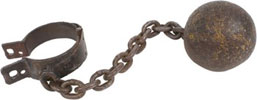 Teacher Guide
to Slavery
Teacher Guide
to Slavery
Slavery is the practice where one human being is treated as the property of another human being. This practice is almost as old as human civilization. Slavery was prevalent in many ancient cultures such as Mesopotamia, and there is reference to it as an established practice in ancient Greece, Rome and Egypt. In the Code of Hammurabi, dated as far back as 1760BC, there are laws about how to treat slaves.
Once human beings moved past the hunter-gatherer stage and started tilling the land and forming towns, levels or stratification started appearing in society. It was no longer just a matter of everyone growing or killing what they or their family needed to eat. People were engaging in taking care of land and in bartering for goods and services. Those who had more resources were able to command a more important position in society. So, it became important to find other people to do the work on the land - this was when the idea of using other people as slaves started. So, much as a trader or rich farmer would own horses, cows or goats, he owned people who would do whatever he wanted. At this time, slavery was not based on race or color but was more often based on wealth.
- Africa Lesson Plans
- Africa Teaching Guide
- Africa Worksheets
- Background Sites
- Black History Month Lesson Plans
- Black History Month Worksheets
- Slavery Worksheets
The wealthy class would have slaves. These slaves were often prisoners of war from another town or country. They were sometimes also people who had borrowed money from the wealthy people and were unable to pay back the debt. Those who were very poor sometimes sold their children to be slaves to other families. Children born to slaves automatically became slaves. It was considered legal to use such people as slaves.
Slaves in the early times were most often from within the same community as the owners. Then came the period when there were prisoners from warring nations. In the Middle Ages there were prisoners of religious wars who were captured and used as slaves. It was in the time of the Industrial Revolution that the international slave trade really became very busy. The Portuguese are said to be the first European nation that started the slave trade from Sub Saharan Africa to their colonies in the Americas, what was then called the New World. Human labor was needed in the sugar and cotton plantations and all the European countries who were trying to establish themselves in North America, South America and the Caribbean brought slaves from Africa to work in their plantations. The African slaves were treated like cargo on the ship and the conditions were inhumane in the plantations also.
While there had been people at various times in history who pointed out that it was wrong to treat fellow human beings as property, the social practice was widely accepted. It is in more recent time in human history that slavery has truly been treated with horror. The abolitionist movement was aimed at making people aware of the terrible reality of slavery. Families were torn apart and men, women and children were made to feel like animals because of the way they were treated.
In the United States, the disagreement over slavery led to the Civil War. The disagreement was between people who wanted to continue the practice because it made economic sense and those who felt that a country born on the basis of individual freedom and liberty should not allow slavery. This war lead to the freedom of slaves in the United States and similar developments happened in many countries and communities. However, today there is still the notion of bonded labor in many countries, and women and children from war-torn countries are sometimes exploited by unscrupulous people who sell them into positions of slave labor. There are organizations that watch and track Human Rights violations which report on such situations to raise global awareness of this continuing problem.
Related Teacher Resources That Are Worth A Look:
- African American Odyssey
- Anti-Slavery.org
- Conflict of Abolition and Slavery
- National Underground Railroad Freedom Center
- Slavery and the Underground Railroad
- The Terrible Transformation